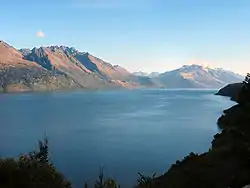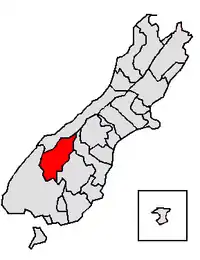Queenstown-Lakes District | |
|---|---|
 Lake Wakatipu, one of the lakes in the district | |
 | |
| Coordinates: 45°01′52″S 168°39′51″E / 45.0311°S 168.6642°E | |
| Country | New Zealand |
| Region | Otago |
| Wards |
|
| Seat | Queenstown |
| Government | |
| • Mayor | Glyn Lewers |
| • Deputy Mayor | Quentin Smith |
| Area | |
| • Total | 8,719.70 km2 (3,366.69 sq mi) |
| Population (June 2023)[2] | |
| • Total | 52,800 |
| • Density | 6.1/km2 (16/sq mi) |
| Time zone | UTC+12 (NZST) |
| • Summer (DST) | UTC+13 (NZDT) |
| Postcode(s) | |
| Postcode(s) | 9300, 9302, 9304, 9305, 9371, 9372, 9382, 9383, 9384, 9672, 9793 |
| Area code | 03 |
| Website | www |
Queenstown-Lakes District, a local government district, is in the Otago Region of New Zealand that was formed in 1986.[3] It is surrounded by the districts of Central Otago, Southland, Westland and Waitaki.
Much of the area is often referred to as Queenstown because of the popularity of the resort town, but the district covers a much wider area, including the towns of Wānaka to the north-east, Glenorchy to the north-west and Kingston to the south.
The district is sometimes called the Southern Lakes, as it contains Lake Wakatipu, Lake Wānaka and Lake Hāwea.
Local government
The Queenstown Borough Council was constituted in 1866.[4] In 1986, Queenstown Borough Council merged with Lake County to form Queenstown-Lakes District Council. In 1989, Arrowtown Borough Council amalgamated with Queenstown-Lakes District Council in the 1989 local government reforms.
The district is administered by the Queenstown Lakes District Council (QLDC) and regionally by the Otago Regional Council.
The Queenstown Lakes District is expected to grow faster than Auckland over the period 2006-31. Statistics New Zealand projections show the district shares the highest growth rate in New Zealand of 2.2% a year with the Selwyn District.[5]
Demographics
Queenstown-Lakes District covers 8,719.70 km2 (3,366.69 sq mi)[1] and had an estimated population of 52,800 as of June 2023,[2] with a population density of 6.1 people per km2.
| Year | Pop. | ±% p.a. |
|---|---|---|
| 2006 | 22,959 | — |
| 2013 | 28,224 | +2.99% |
| 2018 | 39,153 | +6.77% |
| Source: [6] | ||
Queenstown-Lakes District had a population of 39,153 at the 2018 New Zealand census, an increase of 10,929 people (38.7%) since the 2013 census, and an increase of 16,194 people (70.5%) since the 2006 census. There were 13,176 households. There were 19,971 males and 19,182 females, giving a sex ratio of 1.04 males per female. The median age was 34.4 years (compared with 37.4 years nationally), with 6,522 people (16.7%) aged under 15 years, 9,195 (23.5%) aged 15 to 29, 19,317 (49.3%) aged 30 to 64, and 4,119 (10.5%) aged 65 or older.
Ethnicities were 83.6% European/Pākehā, 5.3% Māori, 1.0% Pacific peoples, 9.9% Asian, and 5.9% other ethnicities. People may identify with more than one ethnicity. At 5.3%, the Queenstown-Lakes District has the lowest proportion of Māori people of all territorial authorities in New Zealand.
The percentage of people born overseas was 39.9, compared with 27.1% nationally.
Although some people objected to giving their religion, 61.2% had no religion, 29.1% were Christian, 1.6% were Hindu, 0.4% were Muslim, 1.0% were Buddhist and 2.4% had other religions.
Of those at least 15 years old, 9,312 (28.5%) people had a bachelor or higher degree, and 2,493 (7.6%) people had no formal qualifications. The median income was $40,600, compared with $31,800 nationally. 6,495 people (19.9%) earned over $70,000 compared to 17.2% nationally. The employment status of those at least 15 was that 21,660 (66.4%) people were employed full-time, 4,629 (14.2%) were part-time, and 354 (1.1%) were unemployed.[6]
| Name | Area (km2) | Population | Density (per km2) | Households | Median age | Median income |
|---|---|---|---|---|---|---|
| Queenstown-Wakatipu Ward | 4,481.34 | 23,253 | 5.19 | 7,350 | 32.1 years | $41,000 |
| Wānaka Ward | 4,225.97 | 13,044 | 3.09 | 4,821 | 39.7 years | $38,700 |
| Arrowtown Ward | 12.39 | 2,853 | 230.27 | 1,002 | 38.3 years | $45,500 |
| New Zealand | 37.4 years | $31,800 |
Urban areas and settlements
The Queenstown-Lakes District has four towns with a population over 1,000. Together they are home to 88.0% of the district's population.[2]
In February 2023, Stuff reported that 27% of houses in the Queenstown Lakes District, particularly Queenstown and Wanaka, were unoccupied dwellings that were used by their owners as holiday homes and people who chose not to rent them. Though 650 new homes were built in the district, there was a shortage of rental housing since homeowners preferred to use their homes as short-term accommodation for platforms such as Airbnb. Between December 2021 and December 2022, the online auction platform Trade Me reported a 49% decline in rental listings in the Lakes District. Similarly, the Ministry of Business, Innovation and Employment (MBIE) reported that the number of rental houses between November 2021 and November 2022 had dropped by 100.[7] By November 2022, Radio New Zealand reported that the average home in the Lakes District cost NZ$1.7 million, while a three-bedroom rental cost a minimum of NZ$800 per week and a single bedroom rental NZ$500 or more per week.[8][9]
| Urban area | Population
(June 2023)[2] |
% of region |
|---|---|---|
| Queenstown | 29,000 | 54.9% |
| Wānaka | 12,400 | 23.5% |
| Arrowtown | 3,060 | 5.8% |
| Lake Hāwea | 2,020 | 3.8% |
Economy
In the year to 31 March 2023, the gross domestic product (GDP) of the Queenstown Lakes District was $3,960m, representing 1% of New Zealand's total GDP. Based on ANZSIC categories, the industry sector with the largest contribution to the Queenstown Lakes District GDP was accommodation and food services, at 14.1%. This is markedly greater than the 2.1% contribution that accommodation and food services make to the national economy. The next highest contribution to the district GDP was from construction, representing 10.6% in the district GDP, versus 6.3% in the national economy. Rental, hiring and real estate services contributed 10.5%, compared with 6.2% in the national economy.[10]
As a major visitor destination, Queenstown Lakes District has a much higher proportion of people in employed in accommodation (8.7%) than the national average (1.1%). The four largest industries in the district based on employment were accommodation, cafes and restaurants, house construction, and the operation of sports and physical recreation venues.[11] Tourism as a whole contributed $889 million (24.2%) to the district GDP, compared with 2.7% nationally.[12]
See also
References
- 1 2 "ArcGIS Web Application". statsnz.maps.arcgis.com. Retrieved 24 December 2021.
- 1 2 3 4 "Subnational population estimates (RC, SA2), by age and sex, at 30 June 1996-2023 (2023 boundaries)". Statistics New Zealand. Retrieved 25 October 2023. (regional councils); "Subnational population estimates (TA, SA2), by age and sex, at 30 June 1996-2023 (2023 boundaries)". Statistics New Zealand. Retrieved 25 October 2023. (territorial authorities); "Subnational population estimates (urban rural), by age and sex, at 30 June 1996-2023 (2023 boundaries)". Statistics New Zealand. Retrieved 25 October 2023. (urban areas)
- ↑ Department of Internal Affairs
- ↑ Cyclopedia Company Limited (1905). "Queenstown Borough Council". The Cyclopedia of New Zealand : Otago & Southland Provincial Districts. Christchurch: The Cyclopedia of New Zealand. Retrieved 20 June 2020.
- ↑ Queenstown-Lakes District growth
- 1 2 "Statistical area 1 dataset for 2018 Census". Statistics New Zealand. March 2020. Queenstown-Lakes District (070). 2018 Census place summary: Queenstown-Lakes District
- ↑ Jamieson, Debbie (15 February 2023). "Queenstown and Wānaka housing crisis fuelled by quarter of homes being unoccupied". Stuff. Archived from the original on 20 March 2023. Retrieved 28 March 2023.
- ↑ "Housing affordability crisis continues to grow in Queenstown Lakes". Radio New Zealand. 15 November 2022. Archived from the original on 3 December 2022. Retrieved 28 March 2023.
- ↑ Brown, Tim (28 November 2022). "Queenstown rental crisis squeezes town's most vulnerable". Radio New Zealand. Archived from the original on 4 February 2023. Retrieved 28 March 2023.
- ↑ "Structure of Queenstown-Lakes District's Economy". Infometrics. 2023. Archived from the original on 2 January 2024. Retrieved 2 January 2024.
- ↑ "Queenstown Lakes District – Largest industries". Infometrics. 2023. Archived from the original on 2 January 2024. Retrieved 24 October 2023.
- ↑ "Queenstown Lakes District – Tourism GDP". Infometrics. 2023. Archived from the original on 2 January 2024. Retrieved 2 January 2024.